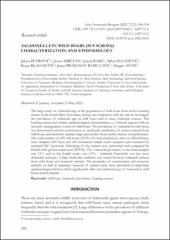Salmonella in wild boars (sus scrofa): characterization and epidemiology

View/
Date
2022Author
Petrović, Jelena
Mirčeta, Jovan
Babić, Jelena
Malešević, Miloš
Blagojević, Bojan
Prodanov-Radulović, Jasna
Antić, Dragan
Metadata
Show full item recordAbstract
The large study on Salmonella spp. in the population of wild boars from twelve hunting
estates in the South-West Vojvodina, Serbia was conducted with the aim to investigate
the prevalence of Salmonella spp. in wild boars and to trace Salmonella sources. The
hunting estates had similar epidemiological characteristics, i.e. lowland regions with an
intensive management system of wild boars. The prevalence of Salmonella in wild boars
was determined and the examination of molecular similarities of strains isolated from
wild boars and domestic animals (pigs and poultry from nearby farms) was performed.
The total number of 425 wild boars (25.3% of total population), shot on official hunts,
were sampled (425 feces and 425 mesenteric lymph nodes samples) and examined by
standard ISO protocols. Subtyping of the isolates was performed and compared by
Pulsed-field gel electrophoresis (PFGE). The Salmonella prevalence in the fecal samples
was 3.1% and in the lymph nodes was 0.2%. Salmonella Enteritidis was the most
dominant serotype. A high molecular similarity was found between Salmonella isolates
from wild boars and domestic animals. The proximity of communities and domestic
animals, as well as improper removal of animal waste were identified as important
epidemiological factors which significantly affect the epidemiology of Salmonella in wild
boars from lowlands.
